How you feel about panty shots can determine how you feel about anime as a whole. And it’s not just panty shots. In the blockbuster anime Food Wars, women’s clothes burst off their bodies when they taste an exquisite bite of steak. Skirts often don’t cover the bottom halves of women’s butts in Prison School. Breasts are regularly the first body part to enter a shot in Is It Wrong to Try to Pick Up Girls in a Dungeon?. In the West, the practice of lacing gratuitous sexuality — and especially female sexuality — into an anime is known as “fan service”. Love it or hate it, anime studios have made a conscious effort to feature “fan service” in newer Western-subbed anime titles.
Unfortunately for some Western anime fans, panty shots and their ilk can be a major turn-off. It’s distracting from the story, they say, and breaks immersion. For feminists, fan service can fall into a media trope that portrays women specifically so they will appeal to viewers attracted to women, and not as flawed, whole people. They say it’s objectifying trash.
But avoiding fan service is easier said than done. The truth is that it’s ubiquitous. Even smart, artful shows like Flip Flappers or Monogatari are riddled with it. Plenty of lower-brow stuff is, too. As anime becomes bloated with fan service, some fans say they have stopped watching. Panty shots are childish and distracting, they argue, even as others who like it say it’s fun or part of the culture of anime. What to make of it? How should a progressive anime viewer think about fan service?
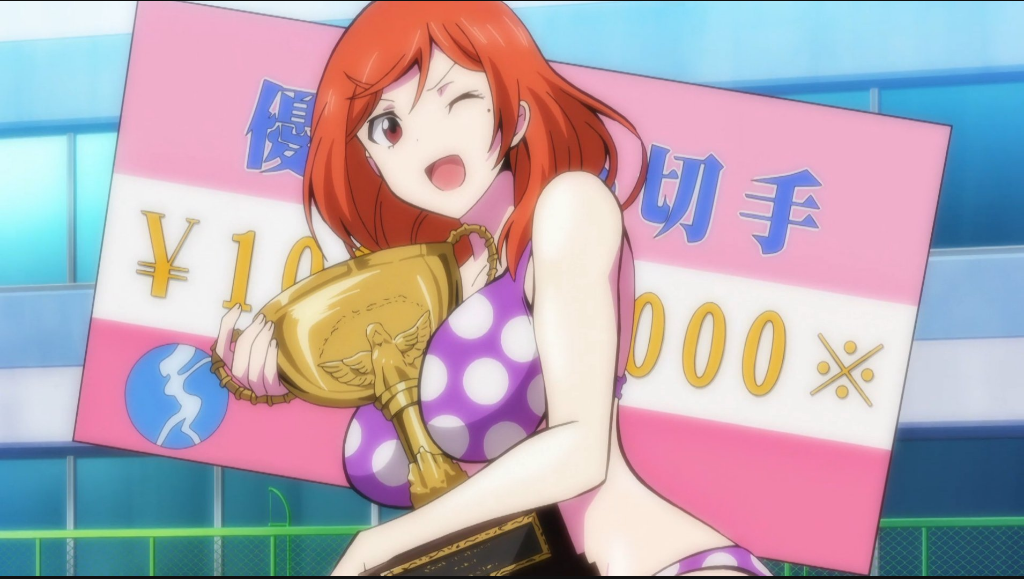
Channing Kennedy, an anime fan and director of the San Francisco Zine fest, recently shared some concerns about fan service, saying, “I hate being complicit in something that I view as a serious social problem: The reduction of women, especially young women, into objects of desire without agency.” He recalled watching the first episode of Rail Wars, an anime about aspiring rail conductors at a specialised high school, when he saw “the presumed female love interest’s entire vagina pressing through her underwear” when she searched a train compartment. He closed the browser tab and, he said, cursed that he couldn’t even watch teens striving to be rail conductors without being slapped across the face with T&A. (A YouTube video montage of Rail Wars fan service describes it as “a reason to pick up” the show.)
It wouldn’t be called “fan service” if it didn’t titillate a significant chunk of viewers, including ones who identify as feminists or progressive. The bouncing anime breasts, upskirt shots, porn-y screams and ripped bodies are relaxing, sexy, fun. “I know exactly how dumb and problematic it is, but I love dumb, silly stuff and life is short,” a progressive anime fan who goes by the name Fujoshi’s Island on Twitter said. “I am a heterosexual male-presenting person of whom 98% of all anime is made for, and frankly, acting like I don’t enjoy anime boobs helps no one.” Anime producers are just giving a large audience what they want (and then selling them figurines and posters to boot), this faction says. If you don’t like it, don’t watch it. It’s just fiction.
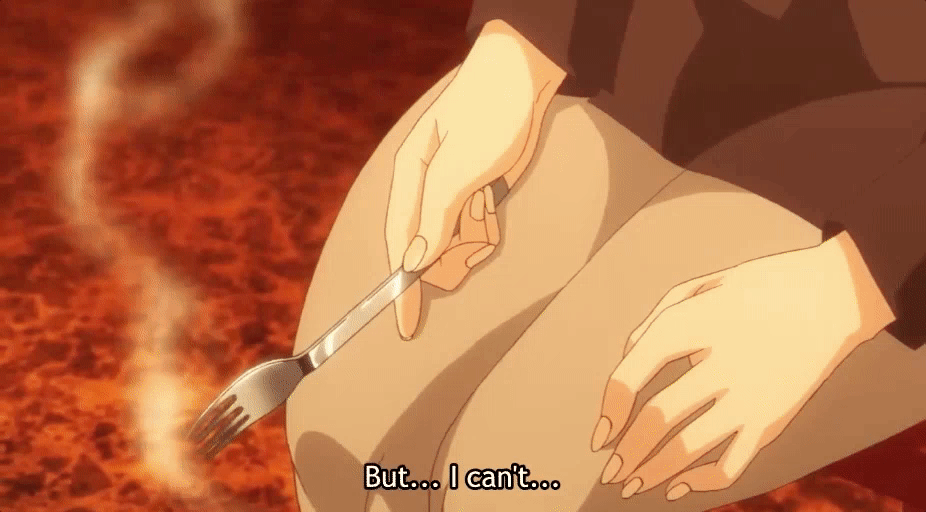
Food Wars
Anime can be a fraught hobby for plenty of fans who identify as progressive. Sometimes, sitting through an episode requires some mental gymnastics or agile skips through overly raunchy scenes. Other times, it necessitates trying to understand why producers put fan service in their anime, coming up with hard rules for a media diet or crafting convincing explanations for friends they show newer anime to. I struggle with this, too. My rules, like many’s, are fluid and probably not rational. It’s tough to put into words — I’ll watch Bakemonogatari, even though an 11-year-old is regularly subject to harassment, but not Food Wars, which contains a distracting breast-to-food quotient.
“Fan service” doesn’t mean the same thing in Japan as it does in colloquial otaku-English. Akiko Sugawa-Shimada, a professor at Yokohama National University, told me that the first reference to “fan service” in Japanese was in a 1978 article on a baseball team and its fans. The term refers to anything a creator inserts into their work to please their audience, including food, dancing or cute animals. Not necessarily sexual, fan service defines a broad umbrella of pleasurable things added to an anime to make it more fun. It could help further the plot, or it could be totally superfluous.
Also, fan service isn’t just panty shots. There’s fan service for straight women and kids, too.
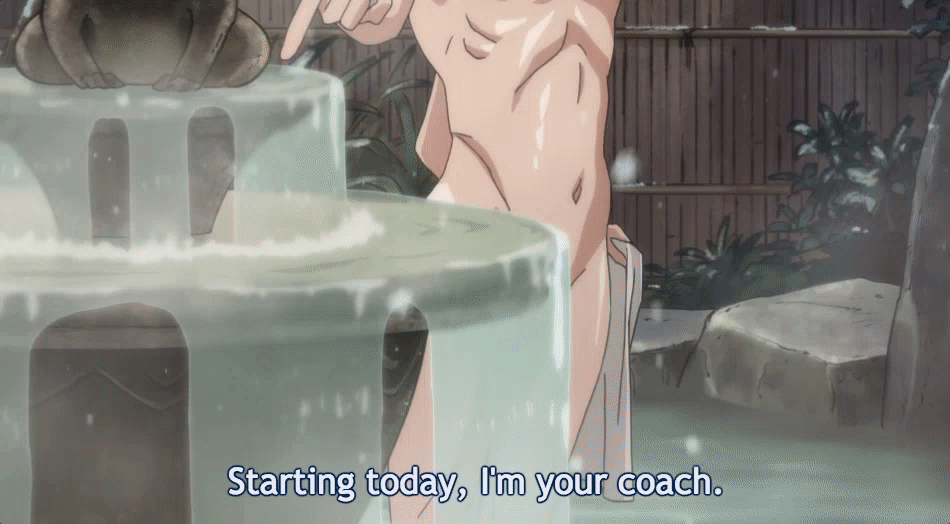
Yuri!!! On Ice
2013’s Free!!! Iwatobi Swimming Club is considered the pinnacle of female-centric fan service. In it, hard-bodied men in tight swimsuits flirt with each other and flex, a sort of grab for straight women’s attentions. This season’s hit Yuri!!! On Ice rides that wave, overtly displaying naked, figure-skating men longingly gazing at each other. Emotional and sensual relationships between men, so lacking in other forms of media, feature prominently in these anime. Some female fans find respite in a genre that nods to their notion of sexuality.
Yuzuru Nakagawa, an associate professor at the Japan Institute of the Moving Image said that Westerners’ perspective that fan service is geared toward men is “simply misunderstanding” the concept. Fan service is broad, and exists for everyone. He says that “progressive” Westerners “just find examples from anime titles which can be read as a representation of degrading women”.
So, if that’s the case, why are panty shots the face of fan service over here? Sugawa-Shimada said that it’s a matter of precedent and a mainstay of more adult anime aired on Japan’s midnight television slots. “‘Fan-sa’ [“fan service”] primarily refers to sexual scenes [meant] to appeal to male audiences,” she said, “because anime works targeting male audiences outnumbered the ones for female audiences during the midnight slots.” Relatively new to the scene are so-called “boys’ love” anime that targets straight women and is designed to titillate them.
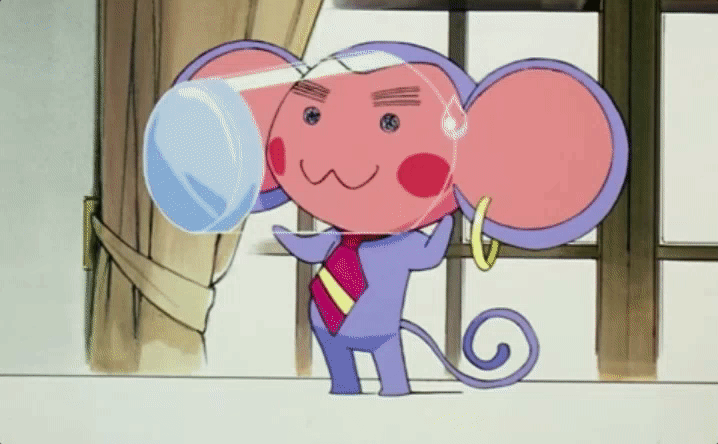
Utena
Regarding so many of those panty shots and other scenes like them, Sugawa-Shimada said that Japanese anime fans “do not take those sexual scenes too seriously”. Bouncy breasts may be comic relief to break up an overly serious narrative. Wind that sends skirts in a flurry can undermine a woman’s raging diatribe against her husband. Half-dressed little boys attempting to be seductive, probably, make some people laugh. It’s light-hearted, Sugawa-Shimada suggested.
Most progressive American anime fans I spoke with described fan service as gratuitous titillation, not necessarily funny, informative or pleasurable to watch. They said, generally, fan service is sexuality artificially inserted into an anime without any bearing on plot or character development. It’s any moment when, for example, an upskirt-shot could be cut out and the anime would remain intact — something purely inserted to turn viewers on. A few called it “pandering”. Food, self-referential jokes or dancing, to many Westerners, doesn’t really qualify as fan service like it would in Japan. It’s mostly about female bodies, and more recently, queer male ones. Also, unlike in Japan, fan service can be a hot issue in the West. (It was difficult to track down Japanese scholars who were anti-fan service.)
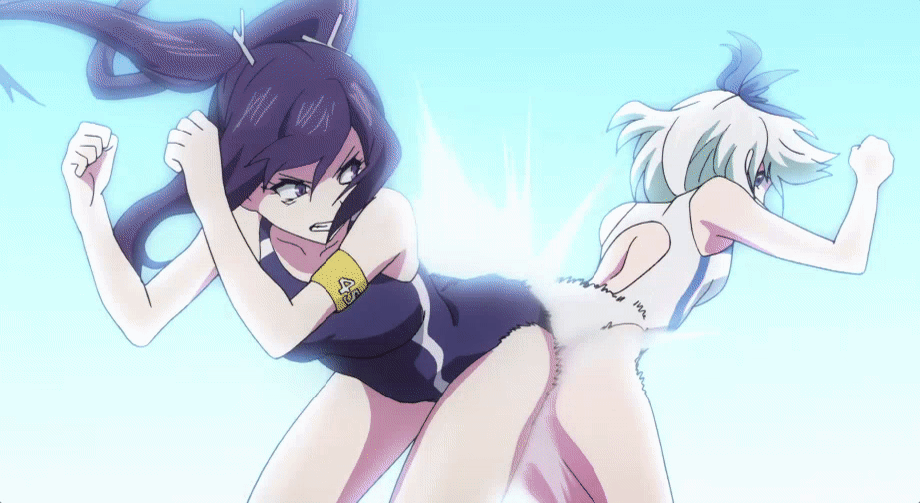
Keijo!!!!!
It’s not necessarily productive to define fan service as “gratuitous”. In Keijo!!!!!, women fight each other with their breasts and asses. The whole thing is fan service. Without it, there’s no anime at all. I recently referred to Keijo!!!!! as “wretched” in a critical article, adding that “in Keijo!!!!!!!!, female erogenous zones are the subject, with a thin plot shambly plastered on top. The occasional up-skirt shot or full-body-pan is an expected, tolerable mainstay of contemporary anime. What I don’t understand is why, despite cultural differences, a lot of Western anime fans see Keijo!!!!!!!! and laugh it off.”
Commenters fiercely defended Keijo!!!!!‘s right to exist and their right to enjoy it, uninhibited from what they considered a left-field, Western critique of Japanese media. Many thanked me for introducing them to their favourite new anime. Their detractors argued that Keijo!!!!!‘s being Japanese didn’t insulate it from criticism. For example: “Some stuff falls under ‘live and let live.’ Probably a lot of it. But there are things that are just wrong and no amount of cultural heritage can defend.” Fan service in Keijo!!!!! is the whole point — so, is it even fan service any more?
Curiously, fans who identified as “progressive” say it’s easier to accept Keijo!!!!!‘s fan service because it’s so unabashed. It’s not hiding. It’s the whole damn thing. But even so, is the whole damn thing just off-limits to criticism?
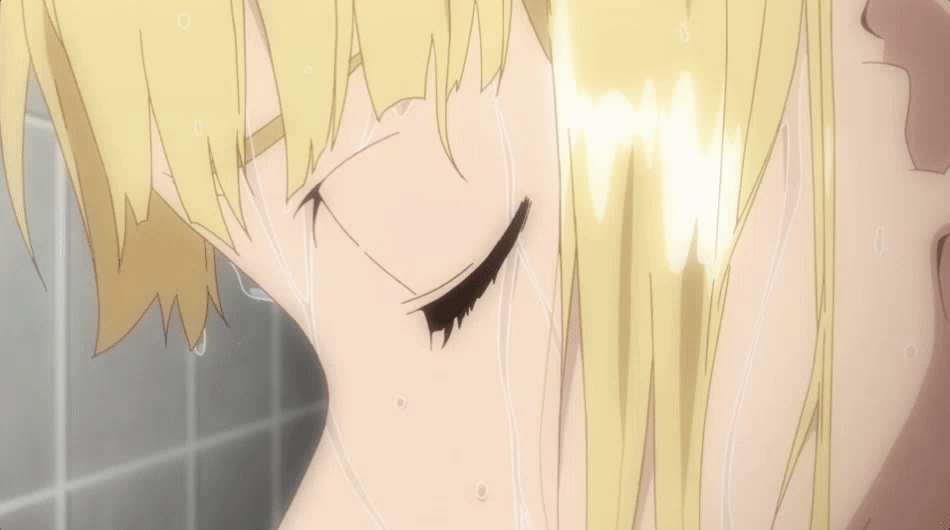
Izetta: The Last Witch
In less radical instances, sometimes fan service helps convey a point, but in a way that’s fun and sexy. Japanese translator and anthropologist Dan Kanemitsu said, “Providing material that audiences enjoy is a given in any work, but storytellers sometimes throw in moments that add nuance and change the tempo at key moments… A character does not need to be shown enjoying a shower, but it does make the character more real.” He’s right — real people are sexual, and giving viewers glimpses of anime characters’ private lives can help us identify with them, and help us learn how they identify with others.
In Bakemonogatari‘s second episode, high school girl Senjougahara repeatedly dresses and undresses in front of protagonist Araragi, flaunting her body and heaping verbal abuse onto him. It’s a brilliant sequence where we learn that Senjougahara couldn’t care less about what others think of her. She’s confident and enjoys playing games with others’ emotions while teasingly keeping them at arms’ length. In just a few minutes, viewers know what she’s about. It’s not tangential to the plot, and even helps further it.
A lot of the time, though, fan service doesn’t have a function outside of turning viewers on.
“I define fan service as any display of sexual content meant to appeal to the viewer and not necessarily add anything of substance to the show,” anime fan Blakinola told me. When an anime has slapstick fan service, he’s more likely to get into it. Or when it illustrates subtle sexual tension between two characters, like Shinji and Asuka from Evangelion, it’s enjoyable. Another progressive anime fan named Raymond told me that he watched Monster Musume because of the fan service, but “if the show wasn’t funny, I probably wouldn’t have watched past the first or second episode.” He added, “You can enjoy something and simultaneously understand and agree why it’s a problem.”
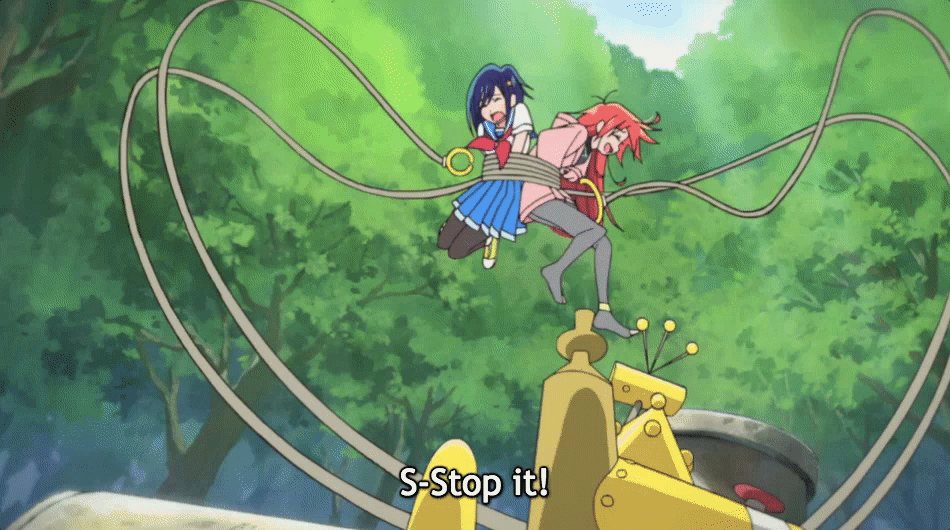
Flip Flappers
Recently, in new magical girl anime Flip Flappers, tentacles randomly burst out of a protagonist’s pet robot and grab two young girls nearby. They yell “No!” as the robot claws at their skirts. To me, it was entirely out-of-sync with the tone of the show, which is about female friendship and fantastical adventures. The scene is jarring. A frequent criticism of hit anime Highschool of the Dead, about high schoolers struggling to handle the zombie apocalypse, is that its well-choreographed fights scenes are undermined by cacophonous boob-jiggling. In Scorching Ping Pong Girls, a ping pong sports anime, a 15-year-old girl’s name is “Mune-Mune”, which translates to “boobie-boob”. The camera regularly zooms in on her chest.
An anime fan who goes by the name Vita and who likes shows with heavy fan service said that some fan service can really detract from an anime’s plot or setting. When it’s “harmless”, like maybe a protagonist’s skirt is just a smidge short, it’s fine; but when it contributes to real-life stigmas that negatively impact certain demographics, fan service takes him out of the experience. He cited Occultic;Nine, which he says has a “mysterious and psychologically unsettling setting” that gets “completely tossed aside” when fan service is introduced. There’s a high school girl with breasts twice the size of her torso and a gay, flamboyant restaurant attendant whom, Vita said, “seems to be used for comic relief.”
“That bothers me because women and gay folks are already misinterpreted so much in the anime industry, and it just adds to the stigma that people shouldn’t take them seriously,” Vita explained.
Anime fan Josh, who also enjoys fan service, told me that it’s pretty clear when fan service hinders more than helps an anime: “If fan service is ‘content that has been added specifically to please audiences, then the kind I enjoy is where that doesn’t take away from the story and doesn’t diminish a character to a mere object,” he told me. “I don’t think nudity or sexuality are necessarily at odds with that.”
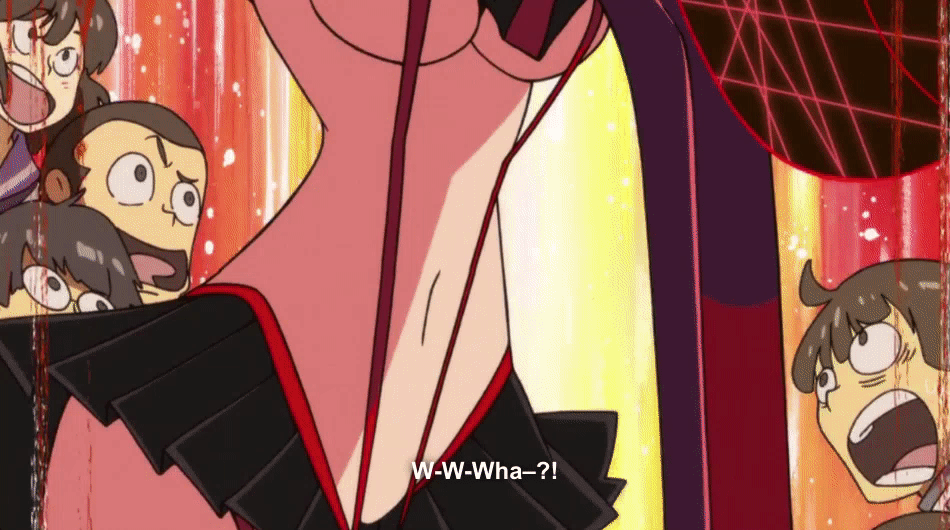
Kill La Kill
But when “fan service” is included in anime without context or any bearing on plot, titillation isn’t the only reason. Sometimes, fan service is meant to self-parody anime. Scenes with young boys taking baths, or wind blowing up girls’ skirts, can inspire a “Ha-ha, this trope again!” feeling. In blockbuster anime Kill la Kill, the young, female protagonist is subjected to every flavour of sexual humiliation, mostly against her will. To fight, she’s forced to wear armour that is basically just suspenders over her breasts and underwear (Once, when someone cosplayed her in Singapore, a bystander called the police). She’s expressly uncomfortable. Her father, whom she’s fighting to avenge, gave it to her. The armour — a sentient, male armour — also feeds on her blood. There’s endless allegory. And it’s an obvious parody of other fighting girl anime, where girls un-self-consciously kick arse in skimpy outfits.
The anime skyrocketed to the top of 2015’s anime charts. It’s a kind of inside joke that doubles as, well, softcore porn. Kill La Kill‘s fan service has been called gratuitous and polarising. But it’s responding to well-established tropes in anime, which ground even its most raunchy scenes.
Where did the precedent come from? It’s hard to say, but recently, anime streaming platform CrunchyRoll filed 1981’s Miss Machiko, one many precedents, to its digital shelves. Miss Machiko was famous for its sexual humour. In it, an attractive, young female teacher’s body is repeatedly exposed by her male students in an attempt to humiliate and embarrass her. In the first episode, a male student pokes at her breasts with a fishing rod and engineers a trip wire attached to a fan that is positioned to blow her skirt up. Even today, it’s pretty shocking that an anime’s entire plot revolves around a career woman’s sexual humiliation.
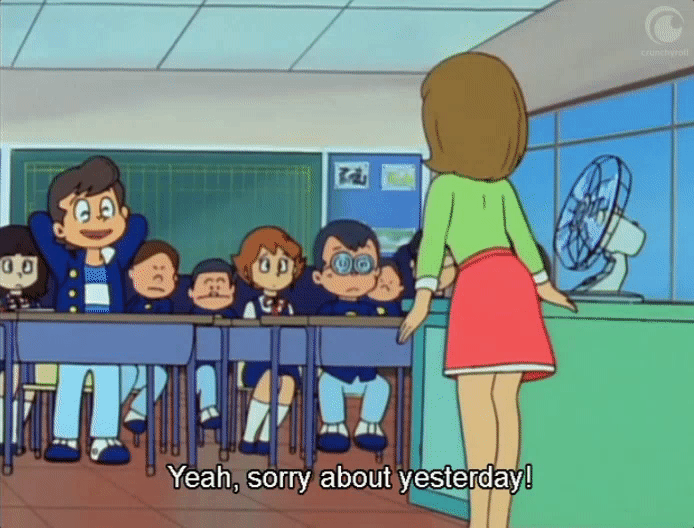
Miss Machiko
A historical explanation isn’t a moral one. Today’s fan service may be parodying anime like Miss Machiko, but in practice, panty shots are still panty shots. It can serve a dual purpose, winking to anime connoisseurs and horny viewers alike. Intention aside, animators are still drawing women in anime to appeal to audiences who enjoy women being sexually humiliated. For fans who identify as “feminists”, that type of content can be hard to watch, and even upsetting.
But feminist-leaning anime fans do watch it. As Raymond put it, “You can enjoy something and simultaneously understand and agree with why it’s a problem… it’s definitely OK to have complicated feelings and opinions about the media you enjoy, because it’s not a reflection of your behaviour.”
“Progressive”-identified anime fans — myself included — judge fan service on a case-by-case basis, and often, can’t adhere to simple rules. The rules are broken over and over again as each new season of anime seems to include more fan service. Many fans with whom I spoke draw similar hard lines for not-OK anime — generally when an anime girl is sexually victimised to turn male viewers on, and when underaged girls are treated as sexual objects or points of attraction.
Amelia Cook, editor-in-chief of anime criticism site Anime Feminist and someone who has a degree in Japanese Studies, said that she takes a hard-line stance against fan service that relies on a lack of sexual consent — if a woman’s breasts are groped for viewers’ amusement, for example. It’s a trope. The main character of The Seven Deadly Sins, which is licensed on Netflix, has a groping problem. In the first episode, just halfway through, he encounters a sleeping woman on a bed. He looks at her. He smells her. He grabs her breast like a rubber horn a dozen or so times, even after she’s awakened, to determine if she’s a woman. Ha-ha!
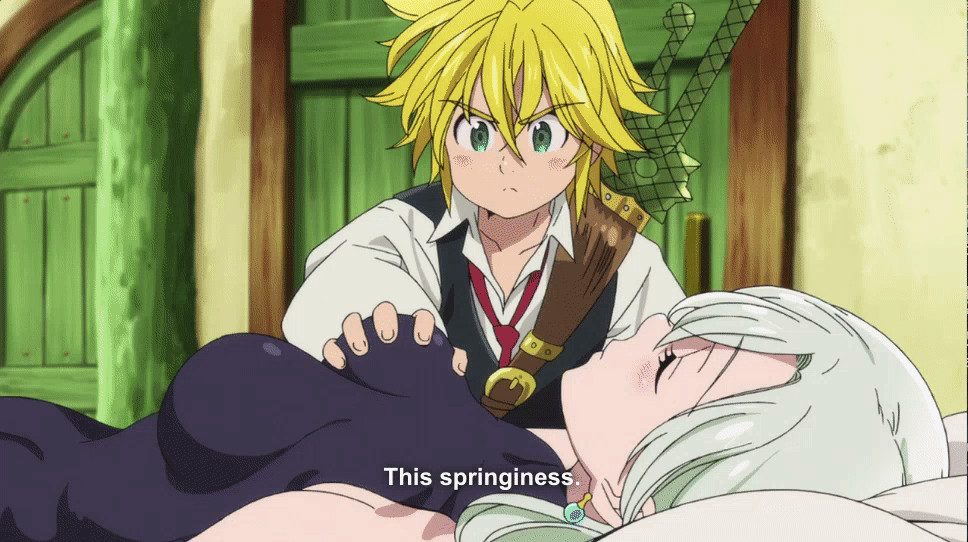
The Seven Deadly Sins
For several progressive fans I interviewed, sexual assault spun as fan service instantly marked an anime unwatchable. Cook added, “Normalising and making light of sexual assault has real world consequences in any country (‘grab her by the pussy,’ anyone?) and I believe anime is no exception to that.” She doesn’t advocate for censorship, just criticism. “I cringe every time I see a boob-grab shoehorned in for ‘cuteness’ and ‘comedy’,” she added.
There are commercial reasons why fan service is everywhere, including where it probably shouldn’t be. It pushes product. Unreasonably large, bouncy breasts make for great figurines and strong, swimsuitted anime boys make excellent bedroom posters. Every time an anime character is objectified, they are commodified. There’s a market for these products, so they’re there, and they sell big time.
“Progressive” anime fans can understand where fan service comes from, why it’s popular and what their personal lines are, but understanding is not a structural solution to finding more anime without fan service. Few people I interviewed, myself included, want fan service to be censored. But considering that the best-rated anime in the West, including Fullmetal Alchemist, Cowboy Bebop, Attack on Titan and Studio Ghibli titles barely trade in panty shots, it’s clear that there’s a path to success for anime without gratuitous fan service. More options, please, is the bottom line.
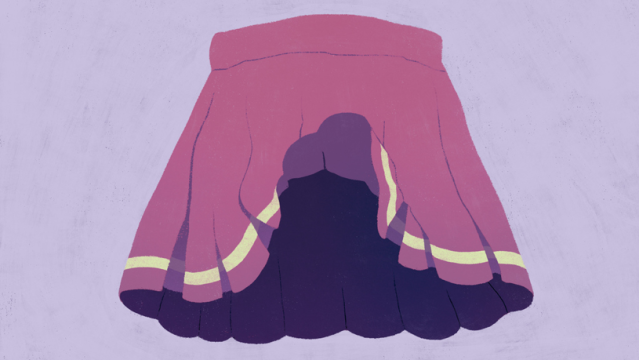
Comments
78 responses to “Anime’s Fan Service Can Be A Minefield”
I wonder if Japan looks at cartoons from other cultures and thinks them weird for not having fan service.
Welp youtuber random interview in Jp actually showed that most Jp folks don’t know/watch American cartoons and those that do and watch Simpsons/South Park and whatnot actually find it interesting for the “dark/adult” humour/topics
So go figure =P
Oh boy, I can’t wait for the comments on this one.
#pornwithunderagegirlsthataretotally5000yearolddemonsmatterstoo
Yeah, that’s the only area I find problematic. Japan allows sexualised depictions of minors, which is something that Western culture generally frowns upon unless you are dolling up kids for pageants or fashion shoots (and even then its frowned upon if you go too far).
Case in point. Valkyrie Drive Mermaid (the anime) says that the main protagonists Mirei and Mamori are 15 and 16 years old respectively, and then show them getting naked and having sexual contact with each other (and other girls). Valkyrie Drive Bhikkhuni (the game) removed the characters’ ages from their descriptions before releasing localised versions. I don’t think it made any difference, as the characters are hyper-developed (G-cup and above), so if you told me they were under 18 I’d struggle to believe it.
It’s more uncomfortable when I see anime girls that are “under-developed” and it would be quite easy to see them as minors, especially with no other indications of their ages, like being in college or something.
I fully expected to hate Kill La Kill because of the way it was advertised and holding a general disdain for fan-service laden anything (it’s definitely not just Japanse animation that does exactly this, an argument I’ve made before in this video
but it ended up being my all time favourite anime and one of the top shows I’ve seen in general – super entertaining but also very clever, it challenges assumptions about almost every aspect of clothing and fashion through the very tropes that makes it appealing to a popular audience.
I think a case by case look at everything, as described in this article, is really the only way to go, KLK totally changed my mind on a lot of things I was certain of in anime and did so while also retaining a light and easily digestible tone that made it a real joy to watch from beginning to end.
The one I always found interesting was the SBS run of Evangelion.
In the teaser at the end of every episode, they would promise Fan Service.
I never really found the fan service in the series to be that extreme.
That being said, I’ve never been one for hyper sexualised stuff in something that’s trying to have a serious story.
I can read food wars easily, but I lasted one episode in the anime, it was too much.
The big one I just couldn’t handle was (I believe) Highschool of the Dead (?)
Bunch of extremely well endowed Highschool students fighting zombies is one thing, but the insane jiggling of the females was more than I could take seriously.
I went from giggling to laughing so hard I couldn’t breathe.
That’s pretty much the point of High School of the Dead. The absurdity of it is meant to be funny. I thought it did a good job in that respect.
Ha ha, the fan service in Evangelion was pretty much limited to Misato and Asuka. It was also pretty tame, which is understandable because the series is not really suited for it.
Pen Pen solely existed for fan service as well.
I wouldn’t dispute that 🙂
You mention “progressive anime fans” a heap of times in the article; I’m just wondering how you decided those specific fans were progressive, and also what you even mean by progressive? How did you decide “yes, x is progressive”?
“progressive” here is a synonym for “SJW”, “liberal”, “PC” or “Pearl-clutching” anime fans.
It’s all subjective anyway. Basically talking about anyone who internalises or seeks to engender feelings of shame in others based on watching something he/she considers taboo.
I mean, it’d be no fun just to not watch something. You’ve got to talk about it and justify why you aren’t watching it and discourage others from watching it and condemn those who enjoy it…
🙂
I like one piece, but I’ll be damned if the way the two female characters – breasts the size of their head, with waists half that – are shown rather annoying. I’d rather tell people I don’t watch it than have them think I do for that alone.
I would rather tell people I watch it for the boobs…
Anythings better than trying to explain how the death of a talking boat, who doesn’t really talk, reduced you to a blubbering mess.
i dont know how you get that far explaining the plot in the first place to even bring up the boobs. Yeah so this kid ate a devil fruit now he’s a half rubber pirate that cant swim who went about recruiting random people to form a crew so he can sail through a rock waterfall dividing the world in search of a dead guys gold.
Generally just explaining an anime to people is enough to turn them away, but introducing people to the worst moments or features of said anime lays in your responsibility, you dont start with the toothbrush scene from monogatari or nearly any scene from everyday life with monster girls and expect not to be judged, thats sort of asking for it, but anyone that watches game of thrones or weeds or any other sitcom should really reflect on themselves before judging others
This kid eats a fruit that gives him the power to act like rubber, but in exchange he can’t swim. He goes off and starts a pirate crew to collect a legendary hidden treasure buried by a legendary hidden pirate, and fights everyone along the way
Man, this is a complex and also rather depressing issue. Personally, I simply can’t stand modern anime any more and just can’t watch it. In fact, I watch more hentai these days than I do actual anime.
Wait, how does that work, I hear you ask. How can you hate an overabundance of fanservice in anime when you watch huge amounts of ACTUAL ANIME PORN?
Well that’s the whole point, isn’t it? Porn is about sex and nudity. That is literally the whole point, although some have plots and even action scenes, basically being normal anime with explicit sex scenes (although I personally find these too much trouble). When I want to watch glistening anime boobs swinging about my screen, I’ll watch some hentai. When I want an actual STORY, though, when I want to watch an actual anime series, I DON’T want glistening anime boobs swinging about my screen. It makes me roll my eyes, because unless it’s an actual ecchi series (like Monster Musume) it’s meaningless, a waste of time, a crutch the studio is leaning on because they don’t believe they can keep their audience interested without it. I want porn in my porn, not my TV series. Besides, if I watch hentai anyway then fanservice is just second-rate hentai, nothing but blue balls (although admittedly sexual content in non-hentai anime these days is getting so explicit that it’s scary). This is why To-LOVE-Ru is my most-despised manga and anime of all time- nothing but an endless succession of a pathetic nonentity protagonist doing every dirty thing possible with the endless hot girls surrounding him EXCEPT actual penetrative sex, all without ever meaning to. It’s laughably dumb.
I remember back when I was first getting into anime. One of my favourite series was Ranma 1/2, the story about the martial artist boy who turns into a girl whenever he gets splashed with cold water. At the time I was quite taken aback by the amount of nudity in the series. But the thing is, the series didn’t WALLOW in it like modern anime does. Ranma turns himself into a girl and pulls his (her?) shirt open to show his breasts in order to gain access to a women’s change room without complaints so he can find something hidden in there… but the camera doesn’t wildly zoom in on his/her bust with an exaggerated bouncing motion, his tits don’t jiggle on their own without provocation or glisten in the light, it was just there. At the start of Project A-ko, one of the best anime movies of all time, A-ko pulls her shirt off over her head while getting dressed in a hurry, revealing her breasts, but then she dives into her closet and the next time we see her, she’s dressed- that’s it. Fanservice was THERE in the old days, but that’s all it was- just there. The camera didn’t linger over it, obsess over it, force it down your throat irrespective of whether or not it had any meaning. It was a bonus extra, entire series weren’t made to hang tits and asses on, like a crappy game made entirely to sell overpriced DLC.
It’s different when the fanservice is actually INTEGRATED into the series. Agent Aika and Najica Blitz Tactics were two late-90s/early 2000s anime which took panty shots up to absolutely comical extremes- there was barely a shot in the entireity of either series which DIDN’T have a panty shot in it. They were completely serious series about spunky female secret agents- which just happened to have panty shots EVERYWHERE, but again, the camera didn’t linger on them or focus on them to the exclusion of everything else. It was practically a satire of panty shots. Try and imagine a James Bond movie (or maybe a Jason Bourne movie would be more appropriate) where the hero wears a banana hammock and no trousers, but no-one ever mentions it and it’s in all other regards a completely normal Bond movie. Eiken was the same thing about boobs, a series with tits so absurdly oversized that they were borderline grotesque (we’re talking a loli with tits literally bigger than her head), which was absurdly blatant with its sexual content (banana-eating contests?) to the point that the entire thing was a parody of fanservice.
Unfortunately, what we have today are shows that are doing the same things these parodical fanservice satires did, but played completely straight because they completely missed the point. Entire series built around fanservice, not because they have a point to make about it or because they’re satirising it, but because they’re just trying to sell softcore porn to horny guys (or straight women and gay guys in the case of shows like Free). Oh sure, they grudgingly put a plot in there as well, but the entire point of the series is to show of dem tiddies, dat ass, and the cameltoe. It’s depressing.
I grew into maturity as an anime fan during the Golden Age of anime (late 90s to the early-mid 2000s) which saw some of the greatest anime of all time made, but now we’re in the Dark Age of anime (yes, the comparison to the early-mid-90s comic book industry is intentional). I believe the turning point came with 2 particular series- UFO Princess Valkyrie in 2002 and Girls Bravo in 2004, the first two anime TV series of the modern era (that I’m aware of anyway) which focused on fanservice more than plot (and often had plot specifically built around providing the fanservice). And now here we are, with stupid crap like Keijo!!!! and Prison School and all this other bullshit. We can never go back…
Great comment. I don’t mind an abundance of fan service but there has to be substance to the anime as well. Otherwise, as you say, you may as well watch hentai anime.
I just finished watching Valkyrie Drive Mermaid, and although there is an extreme amount of gratuitous sex and nudity in the series, it is there due to story reasons, and there is a reasonable (but not excellent) plot as well, enough to make me care about these characters with constantly jiggling/exposed breasts who are forever orgasming and turning into weapons.
You make a good platform but are entirely biased by your nostalgia lens. Agent Aika and Eiken are every bit, if not more, as pandering, reductive and ultimately empty as Keijo or whatever other modern stuff. Older anime are plagued with such examples, but you are happy to give them a pass. Moreover, even the “normal anime” with a plot (sometimes even a /good/ plot) beyond being a thin excuse for fanservice delivery, had tooons of fanservice, just as much as any today. Have you forgotten about Sorcerers Hunters? Slayers? Tenchi Muyo? Dragon Ball? Love Hina? Hell, even artsy anime like Blue Submarine didn’t shy away from it. Conversely, there are good, modern anime series devoid of fanservice.
There is not a “golden” or “dark” era when it comes to that stuff. Your perception is simply warped by several factors: First, nowadays MUCH more anime is produced than before, so even if the /percentage/ of empty “ecchi”-driven series hasn’t increased, there are more of them being produced each season. Second, you are extremely forgiven of the things you first watched as a wide-eyed kid or teenager, full of “first-time” wonder and lacking all “seen there, done that” cynicism. Third, it was different times. The collective opinion regarding objectification, sexism and representation was nowhere near what we have today, so you were less likely to think and feel negatively about what you were seeing, and such tamer thoughts and feelings stay with you today. Fourth, the Internet, I believe, has made us more critical (for good and bad). Whereas we used to just swallow things as they came, accepting the flaws along the worthy, we’re more likely today to voice our disapproval of the flaws, which in turn makes us wonder if the worthy is actually all that worth it. Fifth, you have grown up. What once was (to varied degrees) welcome titillation for a virgin, inexperienced teenager is now seen by your adult eyes as juvenile, pandering, and distracting fluff.
I’ll agree on a lot of those points, but I still think the nature of fan service has changed. At the very least the technology and budgets have made leaps that ensure that it can be injected as often and as causally as the author wants. Computer assisted animation means that they don’t have to be stingy on the amount of characters on screen and moving. Boob jiggle and highly detailed revealing outfits can be on in the background for the entire show.
To use Dragon Ball as an example back then they had to take turns being active or reduce the detail in their activity, so Bulma couldn’t be bouncing around like a maniac while Goku was fighting. It forced a line between fan service and the story. The fan service typically had to be part of the story but it was very hard to make it blend with the story full time. The story led Bulma to Roshi, Bulma flashed Roshi, then the fan service was over and the story continued. Now the story and the fan service can share the stage. There’s no need to turn it off so it’s always on. It almost breaks the fourth wall because Bulma wouldn’t be flashing Roshi, she’d be flashing the audience for the entire duration of the show.
Maybe, to an extent? But not that much, I’d argue. You picked a fairly tame example with Dragon Ball. If you take, for example, Sorcerers Hunters, there was a fair amount of jiggle all over the place.
I do agree with you that whatever extra measure of added unnecessary “boob physics” to otherwise non-‘ecchi’ anime is definitely a result of technological advancement. Hell, I wouldn’t be surprised if there’s like a plugin that automates that kind of stuff now.
You my good sir win all the internets today for that comment! 😀
Pretty much word for word how I feel about the current batch of fan service and anime. If I wanted H material I ‘ll watch H. Being endlessly subjected to pointless blue balling w/o any discerning plot or even a decent lead (yes the Keitaro uselessly lovable idiot was amusing during Love Hina.. but my gawd that trope is utterly overdone so much these days =/) to keep my interest in a series just kills a huge chunk of anime for me these days.
Girls Bravo was amusing and cashing in on Love Hina’s success… the problem was Love Hina became the de facto template for a huge chunk of anime that came after. A lot of variety just disappeared eaten up by either “dark edgy violent” material or full blown fan service harem (heck the most recent animes I could stand was the usual series that didn’t quite fit w/ trends at the time – Nogizaka no Himitsu, Overlord, Hataraku Maou-sama and the recent One-Punch)
“Sexuality.. GET IT AWAY!!” ~ Kotaku Writers 2016
It’s not about the though. It’s about having an entire class of film assume it’s needed when it’s not. It would be like watching TV and having every show have a panty shot or close up of boobs. There’s a place for fan service and a place for not having it, especially when it’s jarring to the tone of a show.
So where’s the place to have it? Because according to the walls of text this “writer” calls an “article”, there’s no place for fan service as it’s all disgusting and ruins everything
Just because you don’t like the writers opinion doesn’t mean you get to be dismissive of their work. It’s a well written, in depth article. While it may go too far in dismissing fan service, it does at least end with stating that we simply would like more options for everyone’s preference.
I can’t help feeling that the article comes from an author that feels that fan service spoils particular anime series that she would otherwise like to watch, while ignoring all the anime series where there is no fan service, but the author is not really interested in or is unaware of them. I appreciate the author can only write from her own point of view, but the result must be taken with a grain of salt.
To be fair, that’s how I feel about most anime, too. There’s a whole lot of ‘so close, yet so far’ anime series out there which are just ruined by not only fan service, but other crap as well. Shoe-horning in some harems, power-creep/plot armour, and other tropes that are signs of lazy writing, or have been put in because of studio pressures to have them there.
My biggest turn-off is still the idiot male lead… it’s been an annoying trend since Love Hina. But at the very least Keitaro seems to have become fairly capable at the final chapters after travelling the world…
.. but it’s been a never ending plague of idiots who just remain idiots w/o any remaining reason to be liked besides the fact that he was “nice”. Or the polar opposite of a fairly capable male lead that somehow manages to loose brain cells when it involves a woman (I’m looking at you Ladies vs Butlers!). I mean I can handle idiots at the start that eventually grow or man-up (ie. Tsukune from Rosario or Nagasumi from Mermaid) or heck just a generally capable reasonable main character like Yuuto from Nogizaka. But they are far and few in between…
Ahhh, ‘potato-kun’. The milquetoast protagonist. Having the personality of a potato means that the intended audience can project themselves onto him.
Yeah. It’s one of the tropes I hate most.
Contrary to the impression given by the article, not all anime has fan service in it.
Either you don’t know what the word ‘sexuality’ means or you really need to see a psychologist about your issues with it.
If that’s what you took from this whole article then I feel bad for you son.
Not as bad as his mum and dad feel though.
‘He just sits in there all day, surrounded by those toys and those, those, PILLOWS.
‘What did we do wrong, Steve?’
*Steve drinks fifth beer, turns away to stare out of window*
‘I don’t know Karen, I don’t know. At least my bloodline ends here.’
I think the main problem is the tendency to use the term as an umbrella. Most anime have fan service of one type or another, but a discerning fan can recognise a few different types of fan-service in shows (or the manga/other sources they were based off) and decide whether it’s tolerable, unbearable, a reluctantly overlooked blemish, or even interesting:
1. The garbage with a hair-thin excuse of a plot, which sole purpose is to show T&A to get teenagers and manchildren to buy DVDs. Basically, porn for people with stunted development. Examples: Eiken, Burn Up W.
2. The run-of-the-mill series full of safe cliches and tropes, including a good dose of fanservice, because why not, people like that too and we may get to sell a bit more merchandise. Examples: Magical Soldier Louie, El-Hazard.
3. The series that use fanservice for comedy effect (usually to break up high tension events) and a bit of titillation. Example: most big-name shounen series like Naruto or DB.
4. Good, big-budget series that want to ensure a commercial success (i.e. DVD and merchandise sales) in addition to critical success and know that some fanservice will help them get there. Examples: The Melancholy of Haruhi Suzumiya, Code Geass.
5. Fanservice that is there because the authors/producers/directors/etc. actually enjoys it themselves. Examples: Anything by Monkey Punch, CLAMP or Rumiko Takahashi.
6. Anime or manga that has kind of a risky or unconventional premise and uses fanservice unabashedly to encourage people to give it a try. Examples: Higurashi, Elfen Lied.
7. Mature (in every sense) anime or manga with adult themes that insert nudity and/or sex because the adults the series is aimed to see such things as a realistic part of life. Examples: Black Lagoon, Blood, Samurai Champloo.
8. Absolute brilliant stuff that parodies, criticises, exploits and pays homage to fanservice all at once. Examples: Bakemonogatari, Kill la Kill, FLCL.
I watched Free! and didn’t find it fan service-y at all. I mean, there is a girl who becomes the manager of the swim team and fantasises about the guys’ bodies a bit, but that’s pretty much it. I suppose that others might find it fan service-y because you can see dudes’ bodies, but for me they weren’t overtly sexualised.
You’ve also got series that (to my mind) aren’t fan service-y at all, like Haikyuu! or Flying Witch, Inazume Eleven or Detective Conan, etc.
Ah yes. I was talking exclusively of series that do use fanservice to any extent.
As for differing opinions on Free!, I guess that it goes to show that there’s also some fanservice in the eye of the beholder? For example, the author of the article found nudity in Ranma 1/2 hardly able to be classified as fanservice (and I mostly agree nowadays), but I know that as a male teenager back in the day, there were several scenes that gave me a tingly feeling. Similarly, I’d bet large amounts of money that for some kids the scenes with the female titan in Attack on Titan were a positively steamy viewing experience.
why is this even a discussion
anime without fanservice is not anime, if you dont like it go watch cartoon
Food Wars also has the male’s clothing burst off when they eat as well thank you very much.
Haha, it’s true.
And there’s only one character in the series who wanders around nude all the time, and it’s a dude.
But that said… maybe it’s just my ‘male gaze’, but I did think they spent more minutes on showing the girls than the boys getting flustered and jiggly. Probably not that much, though.
Such a great series. I learnt a lot about food from it (assuming it wasn’t lying about it).
The loving attention to detail in their cooking descriptions sold me on the series far more than any fan-service possibly could. I swear they have a dedicated art team just for the food shots. It’s food porn, and it is gratuitous about it. To hell with sex, GIMME THAT UMAMI.
And all their food science that I’ve investigated seems to check out. They must have serious researchers going to town on this shit. I love it.
Umami is the best word. Umami.
Honestly I ignored the fan service in it because I was too busy salivating at the food. I always had to eat before watching an episode.
I used to watch Toriko for roughly the same reason.
Although it was irritating that most of the ingredients don’t exist.
There’s a manga about a curry chef that goes in to a lot of detail also, they provide the recepies for many of the dishes and even a list of spices and ingredients as well as the effect it has on a dish.
Never knew I could add coffee to dail back sweetness for example.
Ben-to always used to make me ravenously hungry, too.
Why is it that “progressives” always have so many problems dealing with stuff they don’t like. They should be called regressive since they have regressed to a child like state and have tantrums when it’s not to their liking.
The only person throwing a tantrum here is you, all because someone’s questioning your desire to watch naked prepubescent girls OH BUT THEY ARE 500 YEARS OLD IN THE STORY SO IT’S OK.
Ick.
I think you are jumping to conclusions. Blueey didn’t say he/she liked to watch anime at all. For all we know it may have been a comment on tolerance from a true libertarian 🙂
a) I am 100% sure I am not jumping to conclusions
b) Of course he/she/it does
c) There hasn’t been a true Libertarian for a century or two. The pathetic neckbearded white middle class weeaboos who claim the term now because they want to watch naked prepubescent girls without fear of censure aren’t actually Libertarians, they are just icky weebs clutching at justifications for their deviance
I’m so confused now… you’re either hilariously sarcastic or a nut job.
Dam text and it’s lack of contextual information.
Calm down, everyone.
….And there you go, point proven in one post.
Instead of responding reasonably you accuse me of being a pedophile.
Nice work.
Implying someone’s a pedophile is a pretty serious accusation, not something you should be doing without some kind of evidence. Complaining about progressives is a far cry from that.
Sorry man, I agree with you pretty often here but you’re way over the line with that remark.
I don’t know how; whenever I see him commenting around here, it’s usually calling some person or people he doesn’t like a handful of reoccuring negative terms: “white”, “weeb/weeaboo”, “neckbeard”… I imagine “alt right” will be part of the roster if it isn’t already.
That he would so easily add “pedophile” to the mix doesn’t surprise me at all – it’s what he does. People he doesn’t like, or people he doesn’t agree with politically (or in this article’s case, people with differing opinions on fanservice) – he sees them as sub-human. Below him. By using something as severe as “pedophiles”, he wants people to see the people he doesn’t like and associate them with this socially unacceptable thing, and so the first group will treat the second with the same disgust that he does.
It’s a pretty disgusting tactic, and it’s not at all conducive to debate or discussion.
Beneath the cartoonish anger and nonsense, sometimes there’s a valid point. Not on this occasion though, this is just accusing people of serious crimes for no reason.
Actually, people with those views are indeed sub-human and below me. If you feel the need to pop into any article raising gender issues and defend the rights of oppressed white males to be horrible to women and children, then yes, you’re well below me, champ.
Not saying that you do it on ALL articles, just pretty much every one I’ve seen. I’m happy to believe you missed a few chances to ‘debate’ the ‘political correctness gone mad’.
I’m unsure whether you’re actually so dense as to not grasp sardonic commentary, or whether you understand it perfectly well but just want to get some attention from the cheap seats here.
Well congrats, you got applauded by one of the biggest Men’s Rights Activists and alt-righters around here (there you go Princess, I used the term!), so I guess that’s mission accomplished? Good job mate.
In case it is a lack of understanding, that is not an actual allegation of paedophilia. It’s a sardonic comment on the extreme prevalence of child sexualisation within the ‘fan service’ area and the regular occurrence of bizarre justifications for this ‘art’. Also, fans of this kind of material will be the first to tell you that it’s not actual paedophilia to view and enjoy that kind of content, so you can dial down the outrage-o-meter.
Cynicism isn’t an excuse to say anything you like with immunity, burnside. You’re not being funny calling people pedophiles, you’re just being a dick. Find a better way to express yourself, assuming you’re capable of it.
And that little ‘guilt by association’ thing you tried to do? Don’t be stupid.
Wow, you really do get a narcissistic buzz from acting like you’re the self appointed moral guardian of Kotaku. I didn’t accuse anyone of being a paedophile, that’s something you’re projecting in order to get attention for yourself by generating faux outrage.
It’s not ‘guilt by association’. You judge a person by the company you keep and while you may claim not to be a creepy Men’s Rights Activist, you’re certainly #1 with creepy Men’s Rights Activists based on their approbation of your posts.
However, whether or not you choose to feel guilty about that is up to you.
Given you’re on a judgmental ego trip, I imagine you take your praise wherever you find it in order to fill that gaping void of insecurity.
You’ve constructed a nice, neat little system where you disparage the character of anyone who disagrees with you or with something you’ve done so you don’t have to confront the fact that you make bad decisions.
Just look at the way you’re responding to me, you’re so desperate to find a reason to dismiss the idea that you crossed a line that you’ll use the fact that people I have no control over agree or disagree with something I’ve said as a way to undermine my position. You know that’s utterly illogical, but you’re trying it anyway.
These were your words. Don’t try to bullshit now by pretending you didn’t know exactly what you were saying when you wrote it. You accused a person of having a desire to watch naked underage kids solely on the basis of a disparaging comment they made about progressives. Are you so isolated from the world around you that you honestly think that was a reasonable or acceptable thing to say?
I am being completely genuine when I say this, but I thought you were better than that. From my encounters with you in the past I saw what I thought was someone who was passionate about real ethics and equality, but whose passion made them express themselves too aggressively sometimes. But looking at how quickly and easily you turn your anger on anyone who so much as questions you, you’re starting to paint a different picture, and it’s not a picture that deserves respect.
You made a mistake. You said the wrong thing. You have two choices moving forward: you can accept that you crossed a line and apologise, or you can pretend you’re incapable of making a mistake and plough forward, turning your aggression on everyone in your way. Whichever you choose, it will affect how people regard you and respect you in the future.
Which picture is really you? The passionate advocate of ethics and equality, or the rolling ball of rage content to destroy everything (good or bad) in their path?
I’ll do you a massive favour. Right now, you are engaging in exactly the same thing that I am – burbling your opinions on the internet for your own self-aggrandisement. The difference between us is that you seem oblivious to this.
If you truly want to be the guardian of moral order for random strangers on a video game news site, you’re going about it the wrong way.
Your aggressive, dictatorial judgmental approach doesn’t portray you in the positive light you think it does.
If you want to be the person you seem to think you are, then your first step is to stop responding vituperatively.
Your next step is to only respond when there is a clear call from someone for support, rather than leaping in to defend the rights of oppressed conservative white males.
And the step after that is to present a positive approach to resolution, rather than just pumping your own ego with judgmental commentary to applause from people of dubious character.
However, if all you want to do is engage in internet arguments to pump your ego and get plaudits from dubious denizens of the interwebs, far be it from me to stop you.
@burnside At least you’ve toned down a little, that’s a start.
I’ve given you a positive approach to resolution, burnside. I said quite politely in the first place that you crossed a line, and I haven’t wavered from that despite the fact you’ve tried to attack my character in response. And I’ve been genuine with you this whole conversation, despite your repeated attempts to dismiss me as having an ulterior agenda.
I don’t comment on things online for self-aggrandisement, I comment to engage other people, to have a conversation, to get a view on different perspectives. So I can learn, and through what I learn become a better person. Even in this conversation I’ve asked you questions, for you to explain why you think what you said was appropriate, to try to learn what kind of person you are.
I was cynical about everything when I was younger, but I discovered that it doesn’t accomplish anything. I got mad at people but it doesn’t change anything, it just entrenches people. I assumed the worst of everyone but all that did was make me bitter and unpleasant to be around. It’s easy to hide behind anger and assumptions, but you don’t get anywhere in life by doing it.
You keep coming back to the idea that I’m guarding moral order. Burnside, you called a stranger on the internet a pedophile. You weren’t joking, you weren’t being tongue in cheek, you straight up accused someone of liking naked underage kids. You still refuse to see how that might be an unacceptable thing to say. I have no problem with you verbally tearing someone to shreds if they deserve it, and like I said above I’ve agreed with some of the stands you’ve taken in the past. But attacking someone like that without justification will not stand.
I don’t think I’ve ever downvoted you until your comment above. I don’t like to downvote at all in general, I try to reserve it only for when people are being dicks, not just because I disagree with them. I downvoted you because you crossed a line, and I stand by that. I commented because I thought you needed to know, in case you wanted to retract or reword, in case it was a genuine mistake. I still think you can fix the mistake you made if you wanted to, and the only reason I’m still having this conversation with you is because I still believe there’s a reasonable person under there that can be reached.
If that’s not the case, then this conversation has been unsuccessful, and I’d certainly be disappointed that I misread your character, but it hasn’t been a waste of time.
You seem to be under the misapprehension that other people see the world the way you do.
They don’t.
This is a video games message board. While to you it may be the beating heart of your social world and a primary means of deriving identity, to me, it isn’t.
I honestly don’t care about your opinion of me, and I care even less that you feel that dictating your judgments carries some kind of existential weight.
While I guess it’s great you gain a sense of self validation from your posts on here, you’d be well served to realise others may care a lot less than you do.
You also might want to realise that your unbelievably patronising manner has precisely the same capacity to win hearts and minds as my ‘offensiveness’, which is to say none whatsoever, or slightly less than that.
I doubt you will though, and I also doubt you will accept that you’re doing the exact same thing that I am – talking shit to anonymous people on the internet for no real effect other than your own entertainment.
But if it gives your day meaning, you go for it!
Better than watching anime.
@burnside Nobody’s under the impression this place is anything more than a light diversion. But despite the internet’s power to make it easy to forget, actual people are behind the articles and comments. I doubt you’d go up to a stranger on the street and accuse them of liking to look at naked kids or call them subhuman unless you had due cause, why do it here? It’s still a real person on the receiving end.
You don’t have to have high esteem for this website to have basic regard for other people. From your other posts you clearly hold equality and the humane treatment of everyone as important, how can you reconcile that with such a casual disregard for people you disagree with online? Do you not see the hypocrisy of that?
Over-abundant fan-service is something that bothers me a little in anime.
Obviously some shows are designed around it, and that’s fine, that’s what they’re there for, core to the concept like violence in a first-person shooter.
It’s only really frustrating when something seems like it has an interesting plot that’s trying for dramatic, mature-themed storytelling that tosses in a bunch of up-skirts or boob-shots for no particular reason, that it gets distracting. It feels like it detracts from how seriously I can take the story.
Which is something that I look for more, these days. I’m not really the target audience for MOST of the anime that gets produced. My ‘automatic discard’ pile has gone from just ‘harems’ and ‘magical girls’ to include ‘anything in a high school‘. The audience for anime seems to be 99% teenagers. For every Patlabor or Usagi Drop, I know I’m going to get 99 versions of Asterisk War.
And that’s fine. The mature shows are worth the sifting.
Man it gets wearying, though. Particularly if they pull a bait-and-switch and only ramp up the fan-service after the first ‘tester’ episode or two that you watch to see if it’s going to be worthwhile. If there’s gonna be fan-service, it should be there up-front. Instead of pulling some Muv-Luv bullshit that tricks me into thinking we’re getting Blue Gender when what we’re really getting is more Freezing.
I’m more bothered by detailed violence in anime than the fan-service tbh.
I think they’re pretty much the same thing. Gore seems to fill pretty much the cheap thrill role fan service does.
Well I mean it as my own personal subjective impression. T&A doesn’t fill my gut with the same feelings as detailed anime gore does.
You are seriously missing some good stuff if you blanket ban the whole “Magical Girl” genre. While there’s indeed lots of derivative and patronising stuff clearly meant for doe-eyed 12-year-old girls, there are also some really smart, deep and overall fun series. A guy I used to know and whose opinion on anime I really respect one day opened my eyes to it by saying “the magical girl genre is merely a re-dressing of the Mecha genre. It merely replaces robots and guns with frilly dresses and sceptres, but once you look past the trappings, the potential for great storytelling is there, and many series do seize it.”
Incidentally, other than the infamous semi-naked transformation sequences, most of those series have 0 fanservice.
Yep. I’m perfectly fine with people enjoying this stuff, fan service doesn’t automatically sour me on something that’s fun to watch, but when I’m looking for something serious it’s overwhelming. It shouldn’t be this hard to find a show that’s not about a super boring high school kid being forced to flick tits to save the world.
Personally I don’t mind the idea and concept of fan-service but I do agree at least the sexual kind is being a little overdone these days.
However my stance on it is the same stance I have with video games, there isn’t anything wrong with what we have, just we need more of everything else to balance it out.
As to censoring fan-service, I think that is a little extreme but giving viewers at least the option to turn them on or off in your dvd menu (or whatever) would be a nice compromise.
It’s almost like they’re targeting a particular demographic….
Gratuitous fanservice bugs me too, for what it’s worth.
I watch anime for the story, doesn’t matter whether it’s got fan service or not, it has never bothered me. You have a choice what to watch, and so do I.
I watch it because I enjoy it, doesn’t matter what it contains, if I realise I don’t like it, I watch something else. Seems like a pretty simple concept to me, I wonder why it’s so hard for others though.
For those that don’t want “fan service” (such a general term for any reason to watch a show);
Mushi-shi – well paced with minimalistic art and music
Btoom – dark, elimination style death game
Akagi – its mahjong, like youve never seen it before
Jojos Bizarre adventure – comic styling generational war
parasyte the maxim – alien hand
world trigger – alien invaders
black butler – demon butler
hamatora – super power detectives
is the order a rabbit – cute and its not “fan service”
Majin bone – has an alt dimension power rangers or saint seiya feel about it
toriko – its about food hunters
ushio and tora – monster friendship
terraformers – (first season) super cockroaches
re:zero – infinite lives
kiznaiver – shared pain
tanaka kun is always listless – protaginist sleeps
yuki yuna is a hero – its like being hit with a brick wall of feels halfway
aldnoah zero – civil war earth and mars
bungo stray dogs – detectives with abilities
mob psycho 100 – psychic
march comes in like a lion – dark and light story about shogi
and thats just in my crunchyroll queue not the legions of bookmarks of completed anime
I really do wish fanservice would get toned back to something that feels like it flows with the show. I understand fanservice helps sell many anime’s, so I’m loathe to condemn it, but fuck me its distracting oft to the point of taking away enjoyment.
That one where the MC couldn’t be a hero and had to get a part time job could have been so good if they toned down the fanservice a bit.
That’s a strange looking hat for a thumbnail!